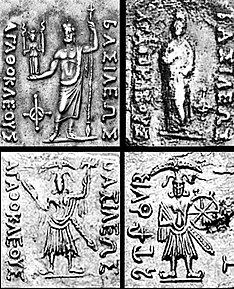| Part of a series on the |
| Indo-Greek Kingdom |
|---|
 |
Indo-Greek art is the art of the Indo-Greeks, who reigned from circa 200 BCE in areas of Bactria and the Indian subcontinent. Initially, between 200 and 145 BCE, they remained in control of Bactria while occupying areas of Indian subcontinent, until Bactria was lost to invading nomads. After 145 BCE, Indo-Greek kings ruled exclusively in parts of ancient India, especially in Gandhara, in what is now present-day the northwestern Pakistan. The Indo-Greeks had a rich Hellenistic heritage and artistic proficiency as seen with the remains of the city of Ai-Khanoum, which was founded as a Greco-Bactrian city.[2] In modern-day Pakistan, several Indo-Greeks cities are known such as Sirkap near Taxila, Barikot, and Sagala where some Indo-Greek artistic remains have been found, such as stone palettes.
Some Buddhist cultural objects related to the Indo-Greeks are known, such as the Shinkot casket. By far the most important Indo-Greek remains found are numerous coins of the Indo-Greek kings, considered as some of the most artistically brilliant of Antiquity.[3] Most of the works of art of the Greco-Buddhist art of Gandhara are usually attributed to the direct successors of the Indo-Greeks in Ancient India in the 1st century CE, such as the nomadic Indo-Scythians, the Indo-Parthians and, in an already decadent state, the Kushans.[4] Many Gandharan works of art cannot be dated exactly, leaving the exact chronology open to interpretation. With the realization that the Indo-Greeks ruled in India until at least 10-20 CE with the reign of Strato II in the Punjab, the possibility of a direct connection between the Indo-Greeks and Greco-Buddhist art has been reaffirmed recently.[5][6][7]
- ^ Holt, Frank Lee (1988). Alexander the Great and Bactria: The Formation of a Greek Frontier in Central Asia. Brill Archive. ISBN 9004086129.
- ^ Cite error: The named reference
RT215was invoked but never defined (see the help page). - ^ "The extraordinary realism of their portraiture. The portraits of Demetrius, Antimachus and of Eucratides are among the most remarkable that have come down to us from antiquity" Hellenism in ancient India, Banerjee, p134
- ^ "Just as the Frank Clovis had no part in the development of Gallo-Roman art, the Indo-Scythian Kanishka had no direct influence on that of Indo-Greek Art; and besides, we have now the certain proofs that during his reign this art was already stereotyped, if not decadent" Hellenism in Ancient India, Banerjee, p147
- ^ "The survival into the first century AD of a Greek administration and presumably some elements of Greek culture in the Punjab has now to be taken into account in any discussion of the role of Greek influence in the development of Gandharan sculpture", in Cribb, Joe; Bopearachchi, Osmund (1992). The Crossroads of Asia: transformation in image and symbol in the art of ancient Afghanistan and Pakistan. Cambridge: Fitzwilliam Museum, Ancient India and Iran Trust. p. 14. ISBN 9780951839911.
- ^ "Following discoveries at Ai-Khanum, in modern-day Afghanistan excavations at Tapa Shotor, Hadda, produced evidence to indicate that Gandharan art descended directly from Hellenised Bactrian art." in Allchin, Frank Raymond (1997). Gandharan Art in Context: East-west Exchanges at the Crossroads of Asia. Published for the Ancient India and Iran Trust, Cambridge by Regency Publications. p. 19. ISBN 9788186030486.
- ^ "We have to look for the beginnings of Gandharan Buddhist art both in the residual Indo-Greek tradition, and in the early Buddhist stone sculpture to the South (Bharhut etc...)" in Boardman, John (1994). The Diffusion of Classical Art in Antiquity. Princeton University Press. p. 124. ISBN 9780691036809.

